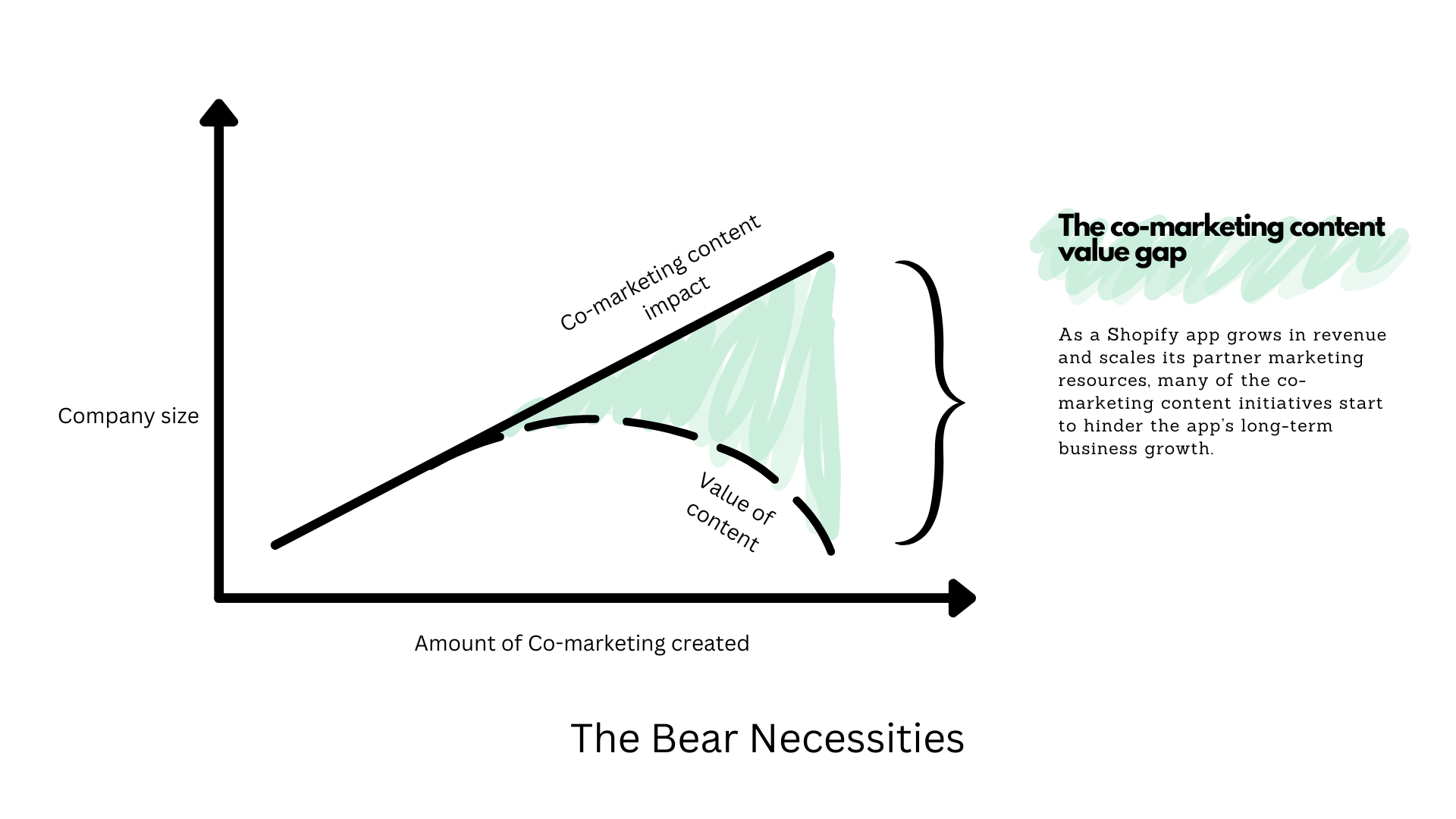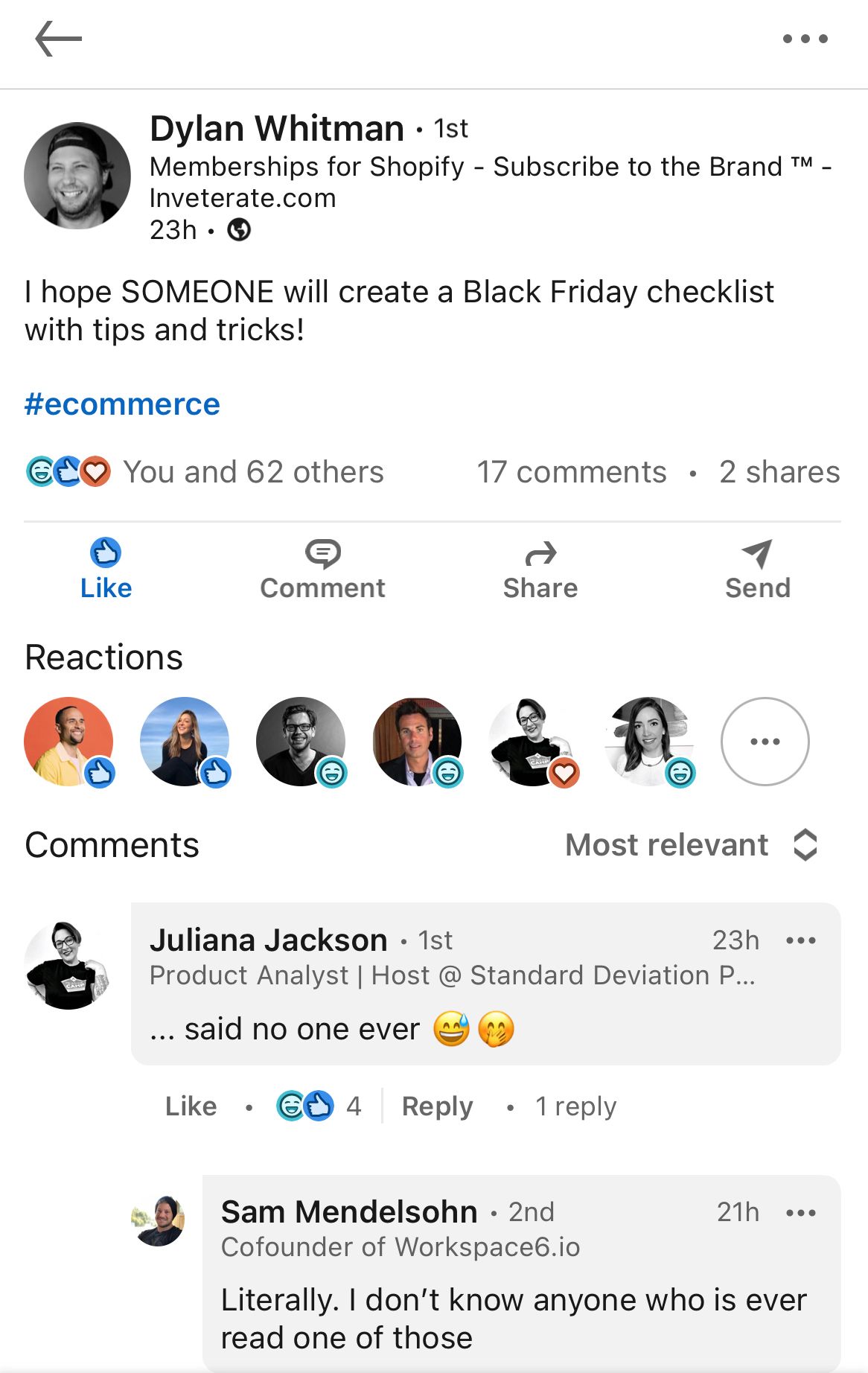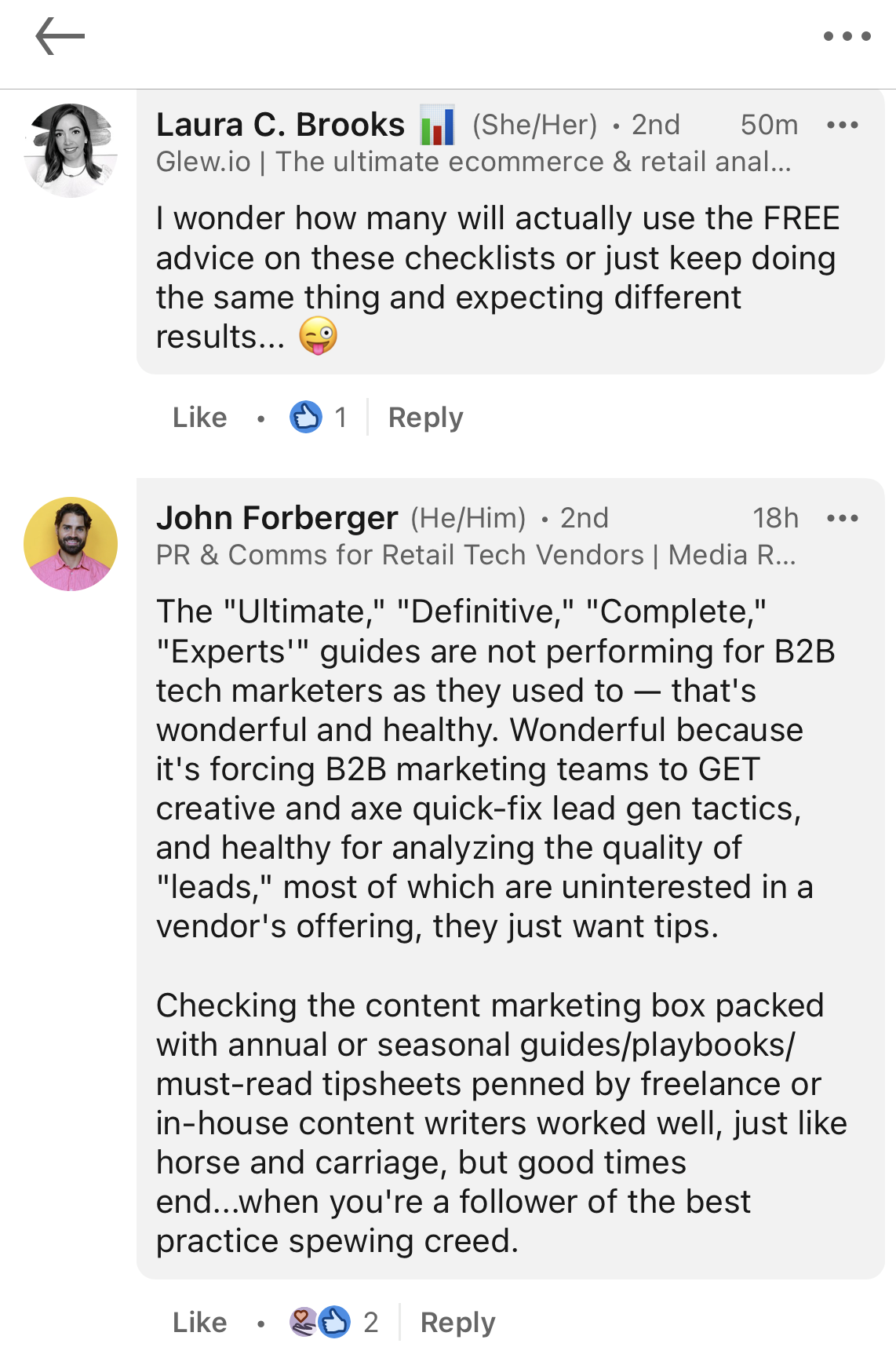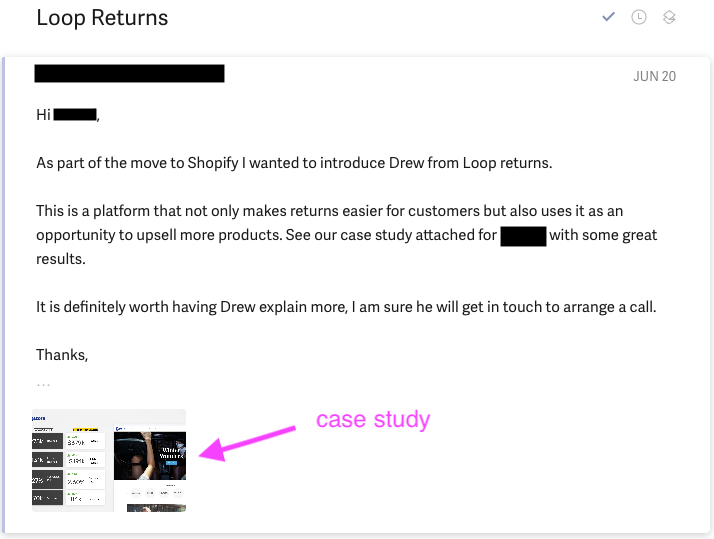The Partner Marketing Content Paradox: Why your co-marketing content is hurting your agency partners and your brand

Today, 99% of the co-marketing content created within the Shopify ecosystem is a depreciating asset.
Which is why I predict that within the next 3 years there will be a co-marketing content apocalypse.
The consequence will be that every co-marketing content piece created by a Shopify tech partner will increasingly make it more difficult to influence enterprise Shopify brands to install the tech partner’s app.
I’m rather bullish on this viewpoint since I’ve spent the last five years in ecommerce -- first agency side at BVA (now The Stable by Accenture) and now tech partner side at Loop, spanning a variety of Go-to-market roles including Sales and Partnerships.
This post will help identify whether your agency co-marketing content is helping or hurting your brand and that of your agency partner(s).
And I promise you, if you’re an agency partner manager, there has never been a more critical time to drive larger Sales Qualified Opportunities (or SQOs) via co-marketing content.
Let’s dive in…
Shopify tech partners & Shopify merchants are similar but different
The marketing challenges faced by Shopify tech partners and Shopify brands are not all that different.
Both have been over-reliant on marketing tactics that have run dry.
For Shopify merchants, they can no longer rely on paid media to build a profitable and long-lasting brand.
The average cost to acquire a new customer has increased by 60% in the past five years.
And the introduction of iOS 14.5 has shown as much as a 40.45% decrease in return on ad spend on Facebook and Instagram.
A more scrutinized approach is needed (which will not addressed here).
And as for Shopify tech partners, there are over 3,200 apps in the Shopify ecosystem.
Every app is fighting for position to be installed by brands. The growing emphasis of brands improving their site speed and decreasing their tech debt is here to stay.
And because of that, brands are more selective of what apps are included in their tech stack.
Shopify tech partners should not expect an enterprise brand to install their app after simply reading their ebook or attending a co-sponsored webinar.
And the ultimate manifestation of this is that Shopify brands are remarkably focused on ad optimization--creative, copy, keywords, channels, etc. (sometimes, even to a fault).
However, tech partners fail to bring the same level of rigor in assessment and optimization to their co-marketing content.
This lack of disciplined accountability in improving the quality of co-marketing content is astounding. Especially given the fact that content marketing is a $400B+ industry today and it’s forecasted to grow to $600B in the next 18 months.
So then where’s the disconnect between the investment and quality of co-marketing content?
For scaling Shopify apps, the main culprit is what I call the Partner Marketing Content Paradox.
The Partner Marketing Content Paradox
Here’s the partner marketing content paradox: as a Shopify app grows in revenue and scales its partner marketing resources, many of the co-marketing content initiatives start to hinder the app’s long-term business growth.
Here are the two primary problems causing this:
- The rise in company headcount at the Shopify app replaces the voices of the core Superconsumers and Visionary
- Shopify apps fall for the trap of the partner co-marketing mirror strategy

1. The voices of the Superconsumers and Visionary are replaced
The best Shopify apps are created from a nucleus team that consists of a visionary and a few superconsumers.
The visionary is the founder. While the superconsumers are usually a couple of engineers, a product manager, and perhaps a growth marketer.
The size of this group is so intimate that their ability to benefit from knowledge sharing happens at a faster pace than larger companies.
And therefore the group is able to advance their level of understanding for merchant issues and complexities on Shopify. Which empowers them to solve problems that the fastest scaling Shopify brands are experiencing.
And as the team naturally grows and brings on more talent (around 75 - 100 people), the original superconsumers grow their way into new jobs/responsibilities.
For some, this means they become managers or perhaps move on to other companies.
And while this is happening, the visionary is constantly in a state of “firing themselves” out of their previous responsibilities by hiring new leaders so the founder doesn't become a bottleneck.
As the company moves past 75 people, they logically prioritize scaling their sales and marketing departments to drive demand and revenue.
However with this scaling, the access to the merchant knowledge obtained from the superconsumers and visionary become difficult to retrieve and pass on in the onboarding process of new sales + marketing hires.
And with the natural pressures of growing the business, most marketing teams at Shopify apps end up heavily prioritizing initiatives that drive revenue in the short term over the long term.
86% of B2B companies outsource content creation to agencies.
And the remaining 14% will typically delegate content creation to someone internally with 1-2 years of writing experience (and even less experience working within ecommerce).
This is because short term growth initiatives are tracked by KPIs that are focused on clicks, downloads, webinar sign ups and more.
And producing more content lures marketing teams into thinking more content produced means more enterprise leads for the business.
Which leads us to the second main cause of the partner marketing content paradox, the trap of the partner co-marketing mirror strategy.
2. The trap of the partner co-marketing mirror strategy
The partner co-marketing mirror strategy is when a Shopify app copies the exact content strategy they see other larger Shopify apps use.
And the content strategy that these more established Shopify apps use is that of a media publication.
Where they produce a large amount of content at a fast pace because they believe that more content will reach more potential merchants.
And that it will also help them stay top-of-mind with their agency partners.
Scaling Shopify apps fall for this trap because they subconsciously inflate the ROI of co-marketing content being produced by their established Shopify app partners.
They assume that the co-marketing content produced by the established Shopify app, that has a larger merchant customer base, correlates to a higher quality of co-marketing content being produced by said app partner.
You can identify this type of co-marketing content because it’s distributed constantly to you.
And the content is filled with obvious “tips”, “tactics” or “strategies”.
Take a quick pause from reading the words I’m typing to you here.
And go check your inbox right now and see how many Shopify app partner newsletters you have.
Open one up. I dare you.
I bet in each of them you’ll see announcements for 25 different webinars, 3 ebooks, 5 blog posts, and 4 podcast episodes sharing the “must know” strategies to be successful for this season.
They all have the same level (or lack) of depth to help merchants. This is called obvious content.
The following is an example of obvious content.
Several Shopify apps partnered together to co-produce a blog on the “6 must-know strategies” brands should use as we finish 2022 👇🏽
Tip: Focus on building relationships, not transactions
"With inflation on the rise, consumers are searching for ways to reduce expenses. If you're not focusing on building strong customer relationships by providing a convenient and valuable shopping experience, your product is going to be on the chopping block.
To fight the effects of inflation, focus on what consumers want most - convenience and value.Implement a subscription experience to make shopping with your brand easy and valuable. Launch a loyalty program to reward customers for staying with your brand
Meet shoppers where they are by communicating with them through SMS. Use your customer data to personalize every aspect of your shopping experience…
Few things are more convenient than having a product arrive directly at your doorstep. Convenience doesn't stop here, however. Give subscribers complete control over their subscription experience, including the ability to pause their subscription, skip a month, and/or swap out a product for a similar item. You're providing convenience through flexibility.” - Shopify app representative
This content is undifferentiated 👆🏽
Any Shopify app could put their name on this quote because it’s watered down. What’s shared is obvious philosophies that most merchants know.
And as a consequence, it lacks valuable insight or frameworks that merchants can apply in their business.
“Use customer data to personalize every aspect of your shopping experience…”
As contributors in the Shopify app ecosystem, how are we helping merchants with that ‘advice’?
It’s gotten to the point where others in the Shopify app ecosystem openly joke about the lack of value being delivered.


Co-marketing content is limiting your agency partners and you from onboarding enterprise merchants
Creating obvious content will contribute to a net-negative ROI for your app’s partner network and for your brand.
And the negative ROI is compounding.
As Shopify merchants continue to scale, their need for unique frameworks and strategies on how to differentiate themselves as a brand evolves.
But when Shopify apps create undifferentiated and obvious content, they’re unknowingly conditioning Shopify enterprise brands to stop paying attention to what the app partner is sharing through their co-marketing.
And as the volume of obvious content increases, the harder it becomes for a Shopify app to engage with potential enterprise merchant customers.
For Shopify apps, their brand value generated through content is a race to the bottom.
Here’s a question to consider… Why do you think it’s difficult for your company’s top enterprise merchants to say “yes” or even respond to participating in webinars or local meet ups your company is hosting?
Much of it is a result of the decisions in content quality your company has made in the past.
And if your content isn’t helping enterprise merchants grow in their business, then how do you expect to help your agency partners win new clients?
Shopify apps are not living out a “better together story” by creating obvious co-marketing content with agencies.
In fact, by asking your agency partners to collaborate in making obvious content, you’re influencing enterprise brands to also not pay attention to the agency’s viewpoint or its services.
And agencies rely heavily on strong word-of-mouth referrals to onboard new clients.
So as an agency partner manager what does one do?
How to start winning with your agency co-marketing content
It’s possible that you’re not a superconsumer at your company.
And that’s ok for the short term. Especially if you recently started working for a Shopify app company. Or have been working in ecom for 1-2 years.
However, the fastest scaling Shopify merchants are no longer looking to grow revenue at all costs. Because the DTC arbitrage strategy has dried up.
Merchants are now looking for approaches to grow sustainably by optimizing their profit margins and decreasing costs.
So a focus for them will be to work with partners and agencies that will be able to solve problems that provide holistic solutions to the brand’s business.
Solutions that are not just DTC or ecommerce centric. But instead retail centric.
In the next 12-18 months we will stop saying the term ‘omnichannel’.
— Harley Finkelstein (@harleyf) October 6, 2022
Doesn’t matter where you buy from.
It’s just retail.
Which is why as an agency partner manager, you’ll need to invest in being a curator.
Someone who is able to capture knowledge from superconsumers about Shopify merchants, consumer behavior, your company’s app, and your agency partners.
By capturing this knowledge, it sets you up on the fastest path to becoming a superconsumer.
Remember, superconsumers are able to identify and solve problems that the fastest scaling Shopify brands are experiencing.
So by becoming a superconsumer in commerce, it will give you the understanding of what co-marketing content is worth creating with your agency partners.
Which will ultimately influence enterprise merchants to actually consider to consume (or engage with) the content in the first place.
Because people don’t have short attention spans. In reality, people have short consideration spans.
And they are continuously evaluating if the content they are currently engaging with is worth paying attention to.
One of the ways you’ll know you’re creating valuable co-marketing content is when your agency partners reference it in their client referral intros.
Below is an email intro from an agency partner of mine that’s referring me to one of their clients 👇🏽

As you can see, the agency has attached the case study I created with our marketing team.
The contents of the case study should speak specifically to how the agency played a crucial role in the success of the merchant's growth in addition to using your company’s software.
This allows you to separate your co-marketing content from obvious content that other Shopify apps are creating.
In a future article, I’ll explain the process for how to capture and create a valuable co-marketing case study with an agency partner.
But if you want to create co-marketing content that drives enterprise leads, start capturing knowledge from superconsumers in proximity to you:
- 1-2 superconsumers at your company
- 2-3 merchant success managers that manage the relationships with some of your largest merchants
- A paid (not free) industry newsletter such as 2PM that curates and creates original thought-leadership content from a macro perspective in commerce
This will allow you to uncover insights that the average Shopify app partner isn’t providing to their agency partners.
And most agency partner managers won’t be diligent in capturing this knowledge because it’s seen as “small matters” that don’t push the needle in driving leads.
It’s seen as not-scalable.
But that’s exactly the point in how to create co-marketing content that stands out with your agency partners that drives enterprise leads.
Being an effective agency partner manager at a Shopify app is the art of attending to ‘small matters’ as diligently as ‘grand ones.’
If this article was forwarded to you by your friend/colleague, feel free to join this conversation by subscribing below
